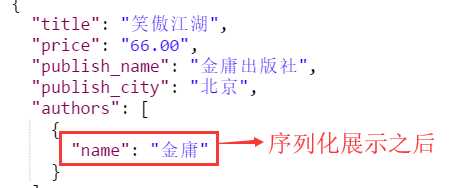DjangoRestFramework之序列化组件
Posted attila
tags:
篇首语:本文由小常识网(cha138.com)小编为大家整理,主要介绍了DjangoRestFramework之序列化组件相关的知识,希望对你有一定的参考价值。
一 . serializers
from rest_framework.views import APIView
from app01 import models
from rest_framework.response import Response
from rest_framework import serializers
# 使用serializers 需要先定义一个类,类里面的内容要和models一致
class BookSerializers(serializers.Serializer):
title = serializers.CharField(max_length=16)
price = serializers.IntegerField()
class BookHandle(APIView):
def get(self, request):
book_msg = models.Books.objects.all()
res = BookSerializers(book_msg, many=True) # 当res里面有多个对象(query_set)的时候要指定many=true(必填)
print(res.data)
return Response(res.data) # 可以用rest_framework里面的Response
def post(self, request):
# print(‘post方法==>‘, request.data)
res = BookSerializers(data=request.data, many=False)
if res.is_valid(): # 这个是对传过来数据与models里面的字段是否对应进行验证
models.Books.objects.create(**res.data)
return Response(res.data) # 按照API接口规范,数据存储成功后要返回
return Response(res.errors)
二 . 学了单表的,来一波跨表的序列化
from django.db import models
class Author(models.Model):
nid = models.AutoField(primary_key=True)
name = models.CharField(max_length=32)
age = models.IntegerField()
class AuthorDetail(models.Model):
nid = models.AutoField(primary_key=True)
birthday = models.DateField()
telephone = models.BigIntegerField()
addr = models.CharField(max_length=64)
class Publish(models.Model):
nid = models.AutoField(primary_key=True)
name = models.CharField(max_length=32)
city = models.CharField(max_length=32)
email = models.EmailField()
class Book(models.Model):
nid = models.AutoField(primary_key=True)
title = models.CharField(max_length=32)
publishDate = models.DateField()
price = models.DecimalField(max_digits=5, decimal_places=2)
publish = models.ForeignKey(to="Publish", to_field="nid", on_delete=models.CASCADE) # 多对一到Publish表
authors = models.ManyToManyField(to=‘Author‘, ) # 多对多到Author表

1 from rest_framework.response import Response 2 from rest_framework.views import APIView 3 from rest_framework import serializers 4 from app01 import models 5 6 class BookSerializer(serializers.Serializer): 7 title = serializers.CharField(max_length=32) 8 price = serializers.DecimalField(max_digits=5, decimal_places=2) 9 # 如果不写source拿到的是object,想要哪个字段,就在source后面写对应表的字段, 10 publish_name = serializers.CharField(source=‘publish.name‘) # book表中publish外键 11 publish_city = serializers.CharField(source=‘publish.city‘) 12 # 多对多的用法 13 authors = serializers.SerializerMethodField(source=‘authors.all‘) # 拿到的是query-set对象 14 15 def get_authors(self, obj): # 函数名格式必须是get_这个类中对应的属性名,obj就是下面book_obj_list里的每一个对象 16 lst = [] 17 authors_list = obj.authors.all() 18 for author in authors_list: 19 dic = {} 20 dic[‘name‘] = author.name 21 lst.append(dic) 22 return lst 23 24 class BookHandle(APIView): 25 # 获取所有数据 26 def get(self, request): 27 book_obj_list = models.Book.objects.all() 28 book_res = BookSerializer(book_obj_list, many=True) 29 return Response(book_res.data) 30 31 def post(self, request): 32 pass
多对一的外键序列化展示,在没有写source之前

写了source之后

多对多的外键序列化展示


以上是关于DjangoRestFramework之序列化组件的主要内容,如果未能解决你的问题,请参考以下文章
